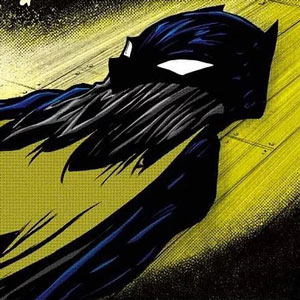
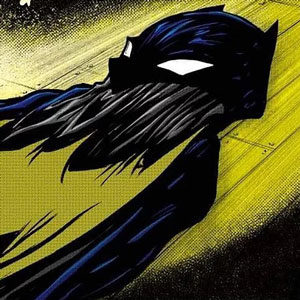 [rating=5]Enormously thought-provoking, delightfully stimulating, and wretchedly heartbreaking, “The Mark of Kane” is a narrative drama that excels in every way. Beautifully written by Mark Pracht and directed by Terry McCabe, this is one of the best shows I’ve ever seen in a long time. This world premiere production by City Lit Theater is not to be missed!
[rating=5]Enormously thought-provoking, delightfully stimulating, and wretchedly heartbreaking, “The Mark of Kane” is a narrative drama that excels in every way. Beautifully written by Mark Pracht and directed by Terry McCabe, this is one of the best shows I’ve ever seen in a long time. This world premiere production by City Lit Theater is not to be missed!
The setting is 2006, when we are introduced to that year’s annual Comic-Con (comics convention) in San Diego. During this nationwide gathering of fans of comic books, comic strips, and comic magazines, we are introduced to a panel of writers and artists who worked on the Batman series: Jerry Robinson (Lee Kanne), Sheldon/Shelly Moldoff (David Valenta), Arnold Drake (Adam Bitterman), and moderator and discussant James Steranko (Michael Sherwin). The audience’s first thought might be that this show about comics trivia is one that might appeal to a relatively small fanbase. Au contraire! “The Mark of Kane” is a story that runs deep. It is a tale about life: about those who succeed in their line of work and those who fail—and whether their measure of success has to do with money or power or relationships or simply getting their best work “out there.” It is a marvelous story about the business of writing and how scripts are developed, using the example of writing comics commercially for major production houses. It is also a timeless account of those who put their stamp on a product while others do the gut work or the “real work” without receiving their fair share of credit or remuneration. Above all, this is a very human story about two friends who worked together to develop the Batman series: with Bob Kane (Josh Zagoren) becoming wealthy and powerful and Bill Finger (Todd Wojcik) constantly getting screwed over and eventually dying as a pauper.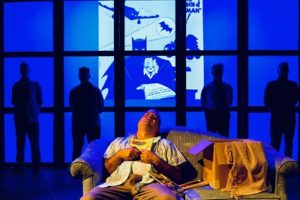
While the idea for Batman might have been Kane’s, it was Finger who lovingly developed the various plots and plot twists that have persisted through time. While Kane may have given Batman his body, it was Finger who gave Batman his soul. Finger knew how to model Batman into such an intriguing character so that there could be a remarkably long-lasting string of comic book adventures to come. It was Finger who created the evil criminals whom we have grown to love by virtue of their wretchedness, such as the Joker.
Due to the fine directing of Terry McCabe, the commentary by Comic-Con panelists is skillfully interwoven into the narrative that begins with a flashback to the year 1939. Although the play largely focuses on the relationship between Kane and Finger, it is also a retrospective on all of their lives. We see how Vin Sullivan (Sean Harklerode), the editor at DC Comics, assigns cartoonist Kane to develop a new superhero to rival Superman—and gives him only a mere weekend for him to develop six pages for artwork and text. Kane recalls his recent acquaintance with Finger, the sort of man who could memorize scripts from comic books as well as lines and stories from great literature—and who carries a book of his notes with him at all times. So when Kane connoiters with him, the two of them together develop the look of Batman—but it is Finger who initially borrows a plotline from “The Shadow” for the first installment of the new comic strip. After their initial success in creating their quintessential hero, Kane’s career skyrockets. But the future is less bright for his collaborators and employees.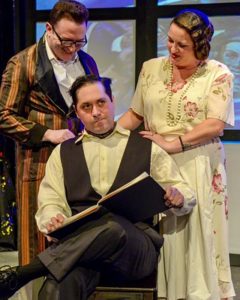
I especially liked the vignettes within the show that examine how family background may have influenced the two men’s personalities. The first is of Finger and his family of origin and how his no-good father Louis Finger (John Wehrman) and his stepmother Tessie (Laura Coleman) could not understand their son’s true genius and his obsession with literature and comics; they keep demeaning him and his pursuits. The next depicts how Kane is treated like a god by his family and how his parents Agusta and Herman Kahn dote on him (Laura Coleman and John Wehrman—take two). Perhaps their diverse upbringing can account for the fact that Kane felt that the world should revolve around him and that Finger thought less of himself than he deserved. What is definitely known, however, is that Kane took his father’s advice: not to be sold short when it comes to his asserting his intellectual property rights. In short, Kane requires that his name be emblazoned on every copy of Batman and that he should receive a percentage of the proceeds in perpetuity for his work.
While the play is a drama, the comedy is riveting, and the timing of the actors is extraordinary! The day I saw the show, the audience was applauding at practically the end of every scene: the story and its buildup were just that great! The intermission broke some of this spell, but it is largely in the second act when we see the dramatic rise of Kane as an arrogant blowhard and the wasting away of Finger, who drinks to excess and whose depression has presumably led to his premature death.
G. ”Max” Maxin IV’s projection design and lighting design is wonderful. It strikes the right chord between reality and creativity. I especially liked how the actors opening and closing the glass doors worked in conjunction with the lights. As a result, the physical set (also his province) can be nicely kept to a minimum. These things put together create an unrivaled scenic design. Costume design by Rachel S. Parent is appropriate to the various eras in which the tale is being told. The underscore composed by Petter Walhlback adds to the doom and gloom of the show and is never intrusive. Poster illustration and onstage comic book art by Tony Donley is superlative: It is commanding and attention-grabbing, often realistic without being real, almost as if taken from the pages of a comic book—but not entirely. Wonderfully apt is his design on the cover of the playbill and on the opening and closing slides.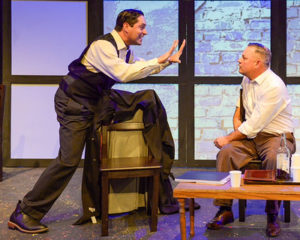
The title of the show “The Mark of Kane” is a play on words. Kane’s mark is clearly on every single one of the Batman comics being published. But the title also has to do with the Biblical reference to the story of Cain and Abel. We might recall that God found Abel’s sacrifice to be more pleasing to Him than Cain’s; and, as a consequence of this seeming favoritism, Cain slew his brother in a fit of anger. God was none too pleased with Cain, especially when he lacked remorse for his foul murder. Although Cain was disgraced and dishonored by his own people, God placed the “mark of Cain” on him so that they would not kill him in revenge. Set apart from them, he was allowed to be prosperous and worldly but destined to live out his life without God. The parallels with Bob Kane and Bill Finger cannot be missed. In Finger’s final line in the show before he dies, he quotes from “A Dream within a Dream”, written by his favorite poet Edgar Allen Poe: “Never to suffer would never to have been blessed.”
Despite his outward material success, Kane was a schmuck in real life, so much so that the 2006 panel has more than enough material to discuss his inexcusable behavior. What a horrible way to be remembered! Finger, in contrast, has a successful legacy. While denied credit for his creative storylines, he influenced a lot of youths who dreamt that they could be strong and powerful—and fight the bad guys like Batman—and yet lead a normal life, with their superpowers completely hidden. Life imitates art, in that Finger’s superpowers were hidden behind Batman’s cloak. Concurrently, Kane has (figuratively) metamorphized into the playboy Bruce Wayne, the last person on earth that anyone would suspect as being “the caped crusader.” So while Kane obviously never turned into Batman per se, he was constantly identified with the name and logo and eventually wielded great power and influence as evinced by his ultimate move to Hollywood to produce the iconic Batman TV show.
It is this contrast of personalities and their respective fates that has paved the way for Pracht to write an incredible play like this one! The detail in this show is incredible, and while you may or may not catch all the references to producers or famous people, this knowledge is unnecessary to understanding the plot. The production successfully draws its audience in and ensnares them. You’ll just have to see “The Mark of Kane” for yourself and judge whether merits the highest marks. This is not just a BANG or a POW or a WHAM. It is a WOW!
“The Mark of Kane” is playing through December 4, 2022, at the City Lit Theater, 1020 W. Bryn Mawr Avenue, in Chicago. City Lit is located on the second floor of the Edgewater Presbyterian Church.
 General admission tickets are $34.
General admission tickets are $34.
Senior tickets are $39.
Students and military tickets are $12.
Performance schedule:
Fridays and Saturdays – 7:30 p.m.
Sundays – 3:00 p.m.
Mondays, November 21st and 28th at 7:30 p.m.
For information and tickets, please go to https://www.citylit.org/ or phone 773-293-3682.
City Lit complies wit the latest official health guidelines for COVID. At the moment of this writing, a mask must be worn throughout the entire church building and inside the theatre.
To see what others are saying, visit www.theatreinchicago.com, go to Review Round-Up and click at “The Mark of Kane”.




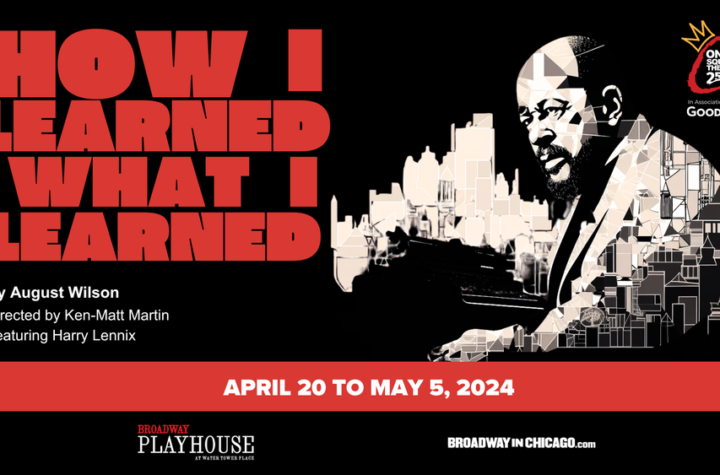

More Stories
“Joe Turner’s Come and Gone”
“How I Learned What I Learned” reviewed by Julia W. Rath
“How to Know the Wild Flowers: A Map” reviewed by Julia W. Rath